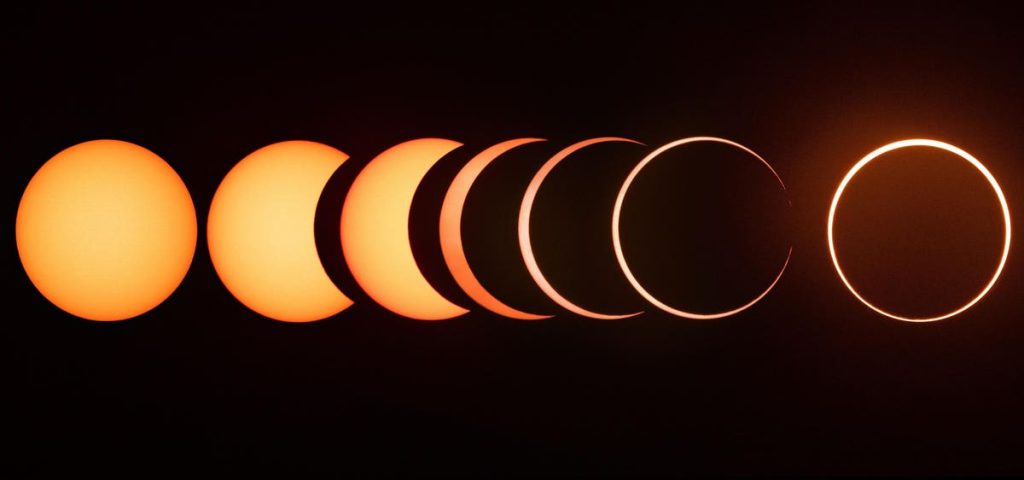When is the eclipse? How long will the eclipse last? What are the best places to see the eclipse? All these questions are being asked in the run up to one of the most important solar eclipses to come to North America for years. However, exactly who will see what and when can get confusing.
That’s largely because on Saturday, October 14 an annular solar eclipse will come to parts of nine U.S. states, though that kind off eclipse’s major sight—a “ring of fire” around the new moon as it briefly blocks the center of the sun—will only be visible from within a 125 miles wide path across the U.S. Southwest.
Staying Safe
Everyone else in the U.S. will see some kind of partial solar eclipse (which will also be visible from almost all of North and South America and all of Central America). It’s important to note that everyone everywhere will need to wear solar eclipse glasses to safely see anything at anytime.
There are some excellent websites to get the maps you need that tell you where and when to see the solar eclipse, as well as how much of it you’ll see. However, a handy way of getting some precise information on the move are from a couple of new eclipse maps apps for smartphones. As well as offering information about the partial solar eclipse and the “ring for fire” they could be really useful if you’re going eclipse-chasing and/or dodging clouds on October 14.
Here are a couple of smartphone apps designed for the solar eclipse on October 14:
‘OneEclipse’ By Astronomers Without Borders
Platforms: iOS (Android version incoming)
Cost: $1.99
A new solar eclipse app created by non-profit Astronomers Without Borders and Simulation Curriculum, the makers of SkySafari (the sleekest planetarium app around), OneEclipse not only gives you a lot of information about the eclipse on-the-go, but also supports a good cause.
As well as countdown on the front page, OneEclipse includes a map that lets you pick a location and see eclipse timings and even a simulation of what the eclipse will look like. It includes precise times for the beginning of the initial partial eclipse, maximum eclipse and the end of the partial. If you’re in the path of the annular solar eclipse then you’ll also get specific times for the appearance and duration of the “ring of fire.” A comprehensive eclipse viewing guide is also included.
The maps don’t load well offline, but when used away from cell service it is possible to get a rudimentary map of your precise position as well as timings for the eclipse. However, a cell reception will vastly increase the quality of the maps.
As a bonus half the fee goes to support AWB, an organization dedicated to spreading the magic of astronomy worldwide, including its eclipse glasses recycling program that helps underserved communities around the world safely watch eclipses. An Android version will go live before the total solar eclipse in the U.S. on April 8, 2024. More information.
‘Totality 3.0’ by Big Kid Science
Platforms: iOS and Android
Cost: free
Created by eclipse-chaser Jeff Bennett, this app has been donated to the American Astronomical Society and comes without ads. It’s an easy way of accessing eclipse maps in a simple, clear way that works great on a smartphone. As well as the annular solar eclipse on October 14, 2023 it also includes interactive maps for April 8, 2024’s total solar eclipse in the U.S. and October 2, 2024’s annular solar eclipse in Easter Island and South America. The maps are pre-loaded so can be consulted offline, though a cell reception is required to get timings for the eclipse for specific locations. Bennet also offers a book of the same name as well as readings.
“I saw a need for an easy to use, free app to help both kids and adults know exactly when and where they could watch an upcoming eclipse and that would provide accurate information about safe viewing and eclipse science,” said Bennett in a press statement. “Eclipse-chasing computer programmer Xavier Jubier generously provided his eclipse-calculation code for use in the app, and the brilliant software engineers at Germinate LLC then turned our vision into reality.” The app was downloaded about 100,000 times in the weeks before the 2017 solar eclipse. More information.
I’m an expert on eclipses—the editor of WhenIsTheNextEclipse.com and author of The Complete Guide To The Great North American Eclipse of April 8, 2024. For the very latest on the “ring of fire” solar eclipse—including travel, safety and observing tips—check my main feed for new articles every day.
Wishing you clear skies and wide eyes.
Read the full article here










